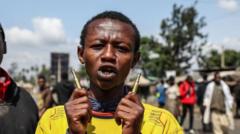This article delves into the alarming global health issue of snakebites in Africa, where limited access to antivenom and medical facilities results in significant fatalities and amputations, particularly among impoverished rural communities.
Deadly Encounters: The Snakebite Crisis in Rural Africa

Deadly Encounters: The Snakebite Crisis in Rural Africa
Millions of Africans face life-threatening snakebites each year, with inadequate access to urgent medical care leading to tragic outcomes.
In Africa, the specter of danger lurks in the grasslands and within homes, where venomous snakes pose an ever-present threat. Each year, millions fall victim to snakebites, leading to nearly 120,000 deaths—a calamity that predominantly afflicts the poor in rural areas with scant medical infrastructure.
The harrowing story of 11-year-old Beatrice Ndanu Munyoki illustrates this dire reality. While tending to her family’s goats in Kenya, she was struck by a snake, leading to swift but inadequate medical response. Her father, David Mutunga, rushed her to a nearby hospital, but they lacked the necessary antivenom for the venom type she had encountered. Eventually, Beatrice received the proper treatment at another facility, but not before her condition worsened—resulting in the heartbreaking decision to amputate her finger.
The figures are staggering; around five million snakebites occur annually, with 120,000 fatalities and approximately 400,000 cases of limb loss due to amputations. This epidemic is exacerbated by human activities such as deforestation, habitat encroachment, and climate change, which disrupt the delicate balance between human and snake populations.
Countries like Kenya, India, and Brazil are rife with such incidents, which reflect a broader struggle for shared resources. As humans expand their territories, the likelihood of encounters with snakes increases, often with tragic consequences. Despite the availability of potent antivenoms, access remains a significant barrier, particularly for rural communities that lack the resources or facilities to manage snakebite emergencies effectively.
Amidst these concerning statistics, tales like Beatrice’s underscore the urgent need for improved access to treatment and public health education in rural regions. Enhanced awareness and accessible medical treatment could be key in preventing future tragedies and saving lives in communities where danger slithers dangerously close to home.




















